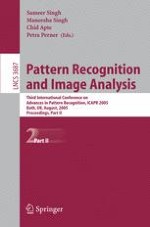2005 | Buch
Pattern Recognition and Image Analysis
Third International Conference on Advances in Pattern Recognition, ICAPR 2005, Bath, UK, August 22-25, 2005, Proceedings, Part II
herausgegeben von: Sameer Singh, Maneesha Singh, Chid Apte, Petra Perner
Verlag: Springer Berlin Heidelberg
Buchreihe : Lecture Notes in Computer Science
